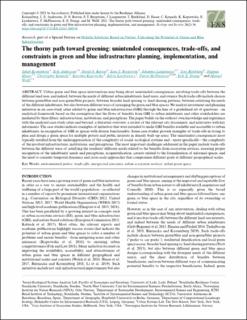The thorny path toward greening: unintended consequences, trade-offs, and constraints in green and blue infrastructure planning, implementation, and management
Kronenberg, Jakub; Andersson, Erik; Barton, David Nicholas; Borgström, Sara; Langemeyer, Johannes; Björklund, Tove; Haase, Dagmar; Kennedy, Christopher; Koprowska, Karolina; Łaszkiewicz, Edyta; McPhearson, Timon; Stange, Erik; Wolff, Manuel
Peer reviewed, Journal article
Published version

Åpne
Permanent lenke
https://hdl.handle.net/11250/2987108Utgivelsesdato
2021Metadata
Vis full innførselSamlinger
- Publikasjoner fra CRIStin - NINA [2397]
- Scientific publications [1423]
Sammendrag
. Urban green and blue space interventions may bring about unintended consequences, involving trade-offs between the
different land uses, and indeed, between the needs of different urban inhabitants, land users, and owners. Such trade-offs include choices
between green/blue and non-green/blue projects, between broader land sparing vs. land sharing patterns, between satisfying the needs
of the different inhabitants, but also between different ways of arranging the green and blue spaces. We analyze investment and planning
initiatives in six case-study cities related to green and blue infrastructure (GBI) through the lens of a predefined set of questions—an
analytical framework based on the assumption that the flows of benefits from GBI to urban inhabitants and other stakeholders are
mediated by three filters: infrastructures, institutions, and perceptions. The paper builds on the authors' own knowledge and experience
with the analyzed case-study cities and beyond, a literature overview, a review of the relevant city documents, and interviews with key
informants. The case studies indicate examples of initiatives that were intended to make GBI benefits available and accessible to urban
inhabitants, in recognition of GBI as spaces with diverse functionality. Some case studies provide examples of trade-offs in trying to
plan and design a green space for multiple private and public interests in densely built-up areas. The unintended consequences most
typically resulted from the underappreciation of the complexity of social–ecological systems and—more specifically—the complexity
of the involved infrastructures, institutions, and perceptions. The most important challenges addressed in the paper include trade-offs
between the different ways of satisfying the residents' different needs related to the benefits from ecosystem services, ensuring proper
recognition of the inhabitants' needs and perceptions, ecogentrification, caveats related to the formalization of informal spaces, and
the need to consider temporal dynamics and cross-scale approaches that compromise different goals at different geographical scales.